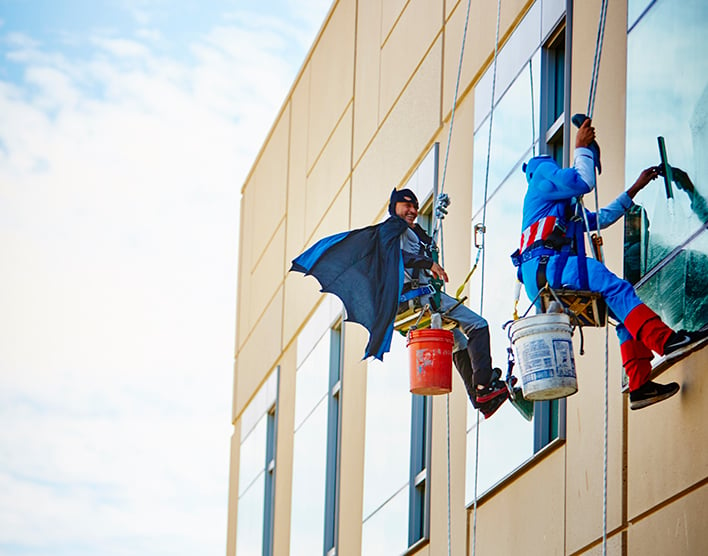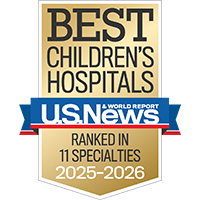Staff superheroes
It’s a bird. It’s a plane. It’s a window washer! Dressed as a superhero to clean and brighten your day.


Blunt trauma like motor vehicle crashes, falls, bicycle crashes and violence causes most of the pancreatic injuries seen in young children.
In older children, a pancreatic injury may happen from a gunshot wound or knife wound that tears and cuts the organ. These types of injuries are known as penetrating injuries.
The pancreas is not well protected in children due to their thin abdominal walls and underdeveloped muscles, so they are more likely than an adult to have a pancreas injury.
The pancreas is found behind the stomach and is divided into three parts: the head, body and tail.
The part of the pancreas lying over the spine is most likely to be injured. Because the pancreas is located close to many other abdominal organs, when the pancreas is injured the physician needs to check for other abdominal injuries as well.
The pancreas is a vital organ, performing functions necessary in the digestion process. The pancreas makes glucagon, insulin and digestive enzymes.
A child with a pancreatic injury will usually have belly pain. Nausea and vomiting are also common. A child may have bruising such as a handlebar mark on the abdomen or he / she may not have any marks at all.
If injury is suspected, your child will be given a physical examination. X-rays, CAT scan (a more detailed picture than an X-ray), or blood tests may be administered to help find out how badly your child's pancreas is injured.
Small pancreatic injuries are usually treated without surgery. A child with a minor injury to the pancreas will go to the general floor unit for a few days of bed rest.
If a child's pancreas is badly injured, surgery may be needed to fix the damage and stop the bleeding. Staples or stitches will be placed if surgery is needed. The child may be given extra blood before or after surgery.
Following surgery, your child will not be allowed to eat right away. However, he or she will be given an IV (a small tube in their vein) for fluids. For a few days after surgery, the Intensive Care Unit team will watch your child closely for any bleeding, pain or infection.
The child is then transferred to the general floor unit as healing continues. The amount of bed rest will decrease and the child's activity level will increase gradually as the injury heals. Keep in mind that each child's healing process is different.
After you leave the hospital, your child will need to be watched for any problems.
Complications do not happen very often but you should know warning signs and symptoms. You will need to call your doctor right away if your child has any nausea or vomiting, fever greater than 100.5 degrees, or belly pain.
Speak to your health care provider about medications your child has previously taken. Your child may have some pain or soreness at home. If this is the case, you may give your child acetaminophen (also known as Tylenol).
Your child's doctor may even give you a prescription for pain medication. Give your child the prescription if the pain does not go away one hour after giving acetaminophen. Follow the directions on the bottle.
However, do not give your child ibuprofen (also known as Motrin, Advil, Aleve, etc.) until the doctor says that it is OK.
Your child may shower or take a bath, but may need help for several days after going home. Check with your doctor about taking baths if your child has had surgery.
If your child has cuts or scrapes on the skin from other injuries, wash the areas with warm, soapy water and pat them dry. If your child has stitches, follow the specific instructions on caring for them.
After the injury, your child may be tired and irritable. It takes time to heal. Use this time for rest and quiet activities. Tell your child that he / she will feel better soon. Have your child play board games, read, or do small craft projects for short periods of time.
Infants and toddlers are more difficult to distract and will be more difficult to confine. Try putting your infant or toddler in a large crib or playpen. Ask family and friends to visit for only short periods of time and not at the same time to minimize activity.
It is very important to teach your child about all types of safety. Your child watches you, so you should also always use proper safety precautions. Your child should learn to wear a helmet when riding a bike, in-line skating or skate boarding.
You should also teach your child to always wear a seatbelt when riding in a car. Remember that children 12 years old and younger should always use correct safety restraints in the back seat when the car has a passenger side airbag.
All children with pancreatic injuries receive follow-up care by the trauma clinic after they leave the hospital. Your nurse will make an appointment before you leave or give you a number to call to make the appointment.
Following the injury, your child may not feel like eating regular foods right away, but it is important that he or she eat a balanced diet and drink as much fluid as before the injury.
Plan quiet activities for your child for the first several days at home. He or she does not need to stay in bed, but walking and playing quietly is fine.
Your child should not play rough with family, friends, or pets. He or she should not participate in any activities or sports that involve jumping, climbing, or running such as bike riding, in-line skating, dance, gymnastics, football, basketball, soccer or track.
Activities like gym class and contact sports are not allowed for some time after leaving the hospital. This will depend on how badly the pancreas was injured.
Your child can go back to day care or school usually one to two weeks following the injury. Your nurse or doctor will help you decide when it is time to send your child back to school.
If surgery was needed or your child has other injuries, he or she may be advised to stay out of school longer. The trauma team will help you with your child returning to school.
UCSF Benioff Children's Hospitals medical specialists have reviewed this information. It is for educational purposes only and is not intended to replace the advice of your child's doctor or other health care provider. We encourage you to discuss any questions or concerns you may have with your child's provider.

Ranked among the nation's best in 11 specialties
Staff superheroes
